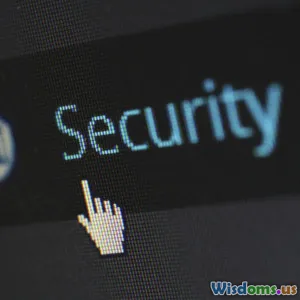
ISO 27001 vs NIST Which Cybersecurity Framework Wins
14 min read Explore the critical differences, strengths, and weaknesses of ISO 27001 and NIST frameworks, unraveling which cybersecurity standard is ideal for diverse organizations and needs. (0 Reviews)
ISO 27001 vs NIST: Which Cybersecurity Framework Wins?
Introduction
Imagine you’re the captain of a ship charting uncertain, digital waters. Around you, storms of cyber threats brew daily—data leaks, ransomware, regulatory penalties. You know you can’t captain that ship alone. Your north star? The right cybersecurity framework.
But which framework will guide you best—ISO 27001, the internationally revered titan, or the NIST standard, backed by American technical rigor? The answer isn't as clear as you might think, and the stakes for making the correct choice have never been higher, with global cyberattacks rising by 38% in 2022 alone (according to Check Point). Choosing between ISO 27001 and NIST is not simply a technical decision. It’s strategic, operational, and business-critical.
In this guide, we’ll break down both frameworks side-by-side, reveal their strengths and weaknesses, showcase real-world examples, and help you navigate the crossroads with confidence.
Chapter 1: Defining the Giants
What is ISO 27001?
ISO/IEC 27001 is an international standard published by the International Organization for Standardization (ISO) and the International Electrotechnical Commission (IEC). It specifies requirements for establishing, implementing, maintaining, and continually improving an information security management system (ISMS) within the context of the organization.
Key facts:
- First published in 2005, last updated in 2022
- Globally recognized, with over 44,000 certificates issued in 2021 alone (source: ISO survey)
- Built on a risk management approach
Purpose: ISO 27001 aims to help organizations of all kinds protect their information in a systematic and cost-effective way, through the adoption of an overarching management process.
What is NIST?
The National Institute of Standards and Technology (NIST), a US government agency, issues various cybersecurity guidelines and frameworks. The two most widely referenced in cybersecurity are:
- NIST Special Publication 800-53: Controls and recommendations for securing federal information systems.
- NIST Cybersecurity Framework (CSF): A voluntary framework for critical infrastructure, adopted widely across sectors.
Key facts:
- NIST SP 800-53, current version Rev. 5 (as of 2020)
- NIST CSF, latest version 1.1 (as of 2018, version 2.0 in 2024)
- Free and widely adopted in the United States; global influence is growing
Purpose: NIST frameworks are designed to guide organizations in managing and reducing cybersecurity risks, providing a comprehensive catalog of security controls and a structured framework for resilience.
Chapter 2: Core Structure & Approach
How ISO 27001 Works
ISO 27001 centers on the Information Security Management System (ISMS):
- Plan-Do-Check-Act (PDCA) Cycle: The standard uses this continual improvement loop, encouraging organizations to make security a living process, not a one-time set of tasks.
- Annex A Controls: 93 controls in themes like access control, cryptography, physical security, and supplier relationships. These controls are selectable based on a tailored risk assessment.
- Risk-Based: Organizations must start with a risk assessment. Controls are implemented to mitigate identified risks to acceptable levels.
Example: A software company conducting services in multiple countries must secure customer data per various laws (GDPR, HIPAA, etc). An ISMS using ISO 27001 begins with a risk assessment, identifies vulnerable touchpoints, then introduces controls (like encryption, logging, vendor audits) tailored to those risks.
How NIST Works
NIST CSF - Five Functions:
- Identify: What assets, data, and risks exist?
- Protect: Protection mechanisms—access control, awareness, data security
- Detect: Timely discovery of cybersecurity events
- Respond: Response steps for incidents
- Recover: Restore capabilities or services
NIST SP 800-53 - Controls Catalog:
- Over 1,000 granular controls grouped in families—ranging from access control and configuration management to supply chain risk management
- Each control has types (common, system-specific, hybrid), baselines, and is customizable by risk tolerance, size, etc.
Example: A defense contractor must meet US federal government rules. Using NIST SP 800-53, every system implements specific controls assigned by the agency: multi-factor authentication, data integrity monitoring, incident reporting, etc., with auditing required.
Chapter 3: Auditability, Certification, and Compliance
ISO 27001 - Certifiable Standard
- Certification: Organizations can become ISO 27001 certified via independent, accredited auditors—this is often a client or regulatory requirement (especially among globally-minded businesses).
- Global Market Credibility: Certification signals discipline and is often required for government and enterprise contracts internationally.
- ISO 27001 Certificate Facts: According to ISO’s 2022 survey, financial and IT services lead in ISO 27001 certifications, but manufacturing and healthcare are growing fast.
NIST - Guidance, Not Certification
- No "NIST Certificate": Unlike ISO, you cannot be "NIST certified." Organizations can achieve compliance or alignment, but this is usually proven via audit artifacts or 3rd-party assessments (e.g., FedRAMP, CMMC for government contracts).
- Mandatory for US Government Agencies: Federal agencies, defense, and their contractors must prove NIST standards compliance.
Real-world Insight: A UK-based fintech wanting to sell to US federal agencies often combines both: ISO 27001 for broad market signals, and NIST compliance to meet government-mandated operational requirements.
Chapter 4: Strengths and Weaknesses—Head to Head
ISO 27001 Pros
- International Recognition: It is an established global gold standard, ideal for multinational organizations or those serving diverse geographic customer bases.
- Management Focused: Emphasizes governance, leadership engagement, and security culture.
- Certifiable: Enables clear communication of security maturity through a widely-accepted certification process.
- Adaptability: Allows for tailored control selection through the risk assessment process.
ISO 27001 Cons
- Potential Bureaucracy: Can lead to a checkbox mentality if not implemented with genuine management engagement.
- Control Coverage: Some controls are high-level—organizations may need more detailed technical guidance (which NIST provides).
- Significant Front-loaded Work: Requires upfront risk assessment, documentation, and culture change which may slow rapid startups.
NIST Pros
- Technical Depth: NIST is renowned for its elaborate and explicit security controls—ideal for complex or high-risk environments (e.g., critical infrastructure, defense contractors).
- Voluntary Frameworks: NIST CSF is flexible and can be applied to any organization, tailoring the rigor of controls.
- Free Public Access: All standards and guidelines are freely available, regularly updated in collaboration with industry and academia.
- US Market Requirement: Essential for doing business with federal agencies or contracts involving American critical infrastructure.
NIST Cons
- Certification Gap: Absence of a universally recognized formal certification may inhibit use as a trust signal outside regulated sectors.
- US-Centric Origin: While adoption grows abroad, some overseas stakeholders or regulators still favor ISO standards.
- Complexity: The detailed controls list can overwhelm smaller organizations if not properly scoped.
Data Point: The 15 largest US federal agencies must prove program-level adherence to hundreds of NIST controls—often at the cost of millions per year in compliance maintenance (Source: Government Accountability Office).
Chapter 5: Real-World Applications
ISO 27001 in Practice
Case Study: British Airways employed ISO 27001 for their international operations, aiming to unify diverse IT teams under one security culture. After certification, the airline improved security incident response times by 35%, according to internal reports, and positioned itself more favorably for major B2B partnerships.
ISO 27001 Best For:
- Businesses with global operations or ambitions
- Vendors/partners needing to signal trust with internationally recognized certificates
- GDPR, HIPAA, or cross-border compliance when global best practices are required
NIST in Action
Case Study: A Regional U.S. Power Utility integrated NIST guidelines after a 2017 ransomware scare. By aligning with the NIST CSF and SP 800-53, the utility improved threat detection with centralized event monitoring and contained incidents rapidly during a later 2020 phishing attack, suffering no data loss.
NIST Best For:
- Organizations with U.S. federal contracts or regulatory oversight
- Companies needing a highly detailed, control-based approach (e.g., energy, healthcare, defense)
- Rapidly scaling startups working in American markets or healthcare technology
Chapter 6: Which Framework Wins? (Or, Why Not Both?)
The truth: No framework is objectively “better.” They serve different global, operational, and technical needs. Many successful organizations use both—leveraging ISO 27001’s management system and certification benefits and NIST’s technical detail and mandatory compliance requirements.
Decision Points Checklist
Ask:
- Where is your market? US federal government? Lean NIST. Global reach? ISO 27001.
- Do you need certification for sales credibility? Choose ISO 27001.
- Do your contracts demand NIST compliance? No alternatives—NIST is mandatory.
- Is depth of technical control your priority? NIST SP 800-53 is unmatched in granularity.
- Looking to build a company-wide "security culture"? ISO 27001’s ISMS is a management-driven approach.
- Do you want to optimize for both? Many organizations design ISMS mappings that reference NIST controls, allowing alignment or dual compliance for maximum flexibility (see ISO and NIST mappings).
Hybrid Approach: The Future?
A growing trend is harmonization—organizations map ISO 27001 management processes to NIST control families, creating a versatile compliance foundation that meets broader market, contractual, and regulatory requirements. The CSA has a crosswalk tool to align these standards, proving their core concepts are more complementary than competitive.
Expert Insight: "We’ve seen best results when organizations don’t pick a side, but instead integrate both standards into a unified program—using the ISMS for governance and NIST for technical controls," says Dana Olson, CISSP, a leading security consultant for Fortune 500s.
Conclusion: Charting Your Security Journey
ISO 27001 and NIST aren’t opposing rivals. Instead, they’re more like powerful navigational compasses—each with its own direction, strengths, and suited terrain. The “winner” depends on where your business sails, which seas you must comply with, and what storms you’ll face.
- Need international credibility and structured ISMS processes? ISO 27001 guides the way.
- Have technical complexity or US regulatory contracts? NIST is not optional.
- Want to maximize trust, resilience, and market access? Blend both: leverage ISO's certification with NIST's deep technical know-how for a cybersecurity posture that is both robust and versatile.
Assess your business’s destination, chart your risks, and let your chosen framework become the helm steering your ship through cyber seas—calm and stormy alike. The key? Don’t ask which framework simply “wins”—ask which one (or combination) wins for you.
Take Action Today:
- Perform a gap assessment against both frameworks
- Consult domain experts to shape your ISMS or control library
- Educate executive leadership on the strategic value—not just compliance—of comprehensive cybersecurity frameworks
Your cybersecurity journey starts not with technology, but with a strategic choice. Choose confidently. Sail securely.
Rate the Post
User Reviews
Other posts in Governance, Risk, and Compliance (GRC)
Popular Posts

















